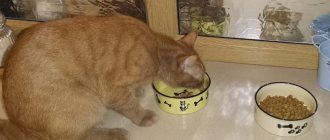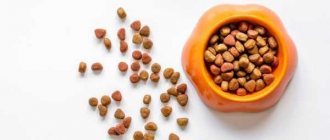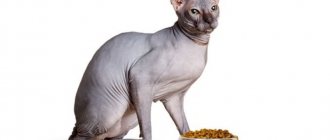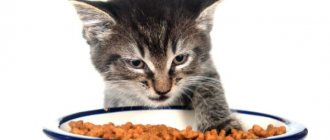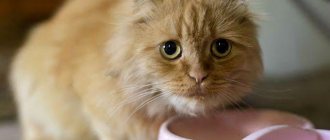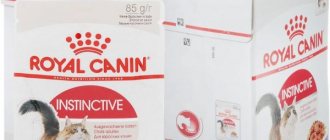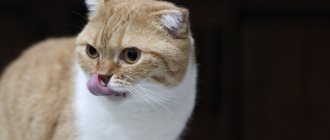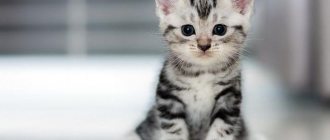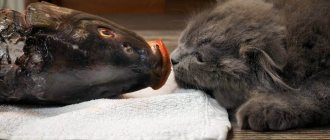A well-fed and healthy kitten is the main goal of furry pet owners. Some owners are sure that there is nothing better than natural products. But with the appearance of various eating disorders and other pathological conditions, the owner is thinking about switching the kitten to dry food.
Veterinarians believe that pelleted food has more advantages than “natural” food. First of all, high-quality dry food is balanced in composition and eliminates the risk of poisoning (which cannot be said about feeding meat or fish).
Before switching to dry food, you need to know their types and select the one that is most suitable for your pet, based on the individual characteristics of the body and breed.
Benefits of dry food
The best food for a cat is mice and birds. It is clear that it is impossible to afford this in an urban environment. And so balancing the diet in order to calculate the required level of proteins, carbohydrates, fats, vitamins, taurine is also not always possible. Industrial food is convenient in this regard, because manufacturers offer ready-made diets that do not require supplementation with vitamins and other products. And the better the quality of the diet, the closer it is to “natural” food - birds and mice.
The second advantage of a dry ready-made diet is ease of feeding. It is enough to measure the dose of croquettes in accordance with the instructions, age, weight of the pet and pour into a bowl.
A wide range of products is also a plus. It is easy to choose a product depending on age, health status, and physiological characteristics. After all, for cats suffering from urolithiasis who have undergone sterilization or castration, switching to dry food is the only way to maintain health. The same goes for animals with allergies, for whom hypoallergenic food is prescribed as treatment.
Is it acceptable to soak dehydrated feed?
According to most veterinarians, soaking freeze-dried (dry) food is acceptable and absolutely safe, since this simply restores the moisture content in the product.
Dry food can be diluted with water
When should dry cat food be soaked?
Dehydrated food is a complete and balanced food that does not require any preliminary preparation. But sometimes it becomes necessary to resort to softening it by soaking.
Situations may be as follows:
- The pet consumes little liquid, as a result of which the solid granules do not completely dissolve in its stomach. Dry ingredients have difficulty moving through the gastrointestinal tract, which can lead to constipation and even obstruction. Stagnant and decomposing food releases toxic substances that lead to intoxication of the cat's body.
- An aging animal begins to have problems with its teeth, which makes it unable to chew dry pieces of food.
- Kittens undergo age-related changes in their dentition and cannot fully chew hard kibble.
Small kittens cannot chew dry granules when changing teeth - An animal greedy for food eats very hastily, practically does not chew the food, but swallows the pellets whole. Large hard pieces injure the mucous membranes of the gastrointestinal tract, against this background gastritis can develop, and subsequently a stomach ulcer.
- About 10–15 minutes after eating, the cat vomits, during which large dry pieces of granules are expelled from the body. This means that the digestive system cannot digest such food.
- When switching from feeding natural foods or wet (canned) food to dehydrated kibble.
- The pet is weakened by illness.
The cat's body spends all its energy on eliminating toxins, spending a large amount of fluid on this. A cat weakened by illness simply does not have the strength to chew solid food. - After surgery, the animal simply does not have the strength to chew the granules.
Veterinarians and breeders consider feeding cats with soaked food only as a necessary measure or a transitional stage to another nutritional option. Only in exceptional cases is it permissible to use it on an ongoing basis.
Our cat came to us as a very small child. Then she still didn’t really know how to drink herself, much less chew dry granules. Since it was decided to feed her only dry food, we had to work hard to accustom her to this specific diet. At first, we soaked dry kitten food in sterilized baby milk; this capricious one flatly refused to consume other dairy products. And sometimes they mixed in (for the smell) a little wet food from bags. At first, the food had the consistency of liquid porridge, then gradually the mixture became thicker. When they started giving just swollen food (not mashed), they added dry granules a little at a time. At first, the cat carefully left them untouched on the saucer, hugging the wet food around it. Then she started eating everything and the need to soak the food disappeared.
Can soaked food cause the formation of tartar?
Some manufacturers of freeze-dried pet food authoritatively claim that chewing hard granules trains teeth, promotes self-cleaning and prevents the formation of plaque. But this is just a publicity stunt. In fact, with this type of nutrition, some teeth (fangs, for example) are not used in the chewing process. Any experienced practicing veterinarian will confirm that when a cat eats pelleted food, harmful plaque also forms. Stone formation is promoted by the microflora in the mouth and the mineralization of saliva, which depend on a balanced diet.
Tartar can form in a cat due to an unbalanced diet.
What to consider when switching to dry food
Adult cats get used to the structure and consistency of their food. Therefore, if you simply put a bowl of granules in front of your pet, at least it will cause him confusion. When changing the type of food, it is important to follow a number of recommendations.
Select food
The first step you need to take before teaching your cat to eat dry food is to choose a brand. Veterinarians recommend a product from the super premium or holistic line. Their main advantage is the high content of meat ingredients. The cat will happily switch to cheap food on its own. Since the manufacturer does not regret adding tempting flavors to the composition. But there is no benefit from such products.
One of the criteria for good food is the daily requirement. The lower the manufacturer declares the daily dose, the better the product. This means that it contains few “unnecessary” components for the cat’s body.
Be patient
The cat may resist switching to a ready-made diet and plaintively beg for its usual food. The owner should be patient with the pet. And under no circumstances should you scold a cat. He will never understand why he is being scolded. He will associate new food with negative emotions.
During the transition period, it is advisable to exclude treats, even if the cat is accustomed to them. He must "focus" on the new diet.
Translate gradually
The key to success in accustoming to a new food is a gradual transition. You cannot be guided by the statement - “if he wants, he will eat.” You need to gradually replace your usual food with a new one. The fact is that with a sharp change in the moisture content of food (and there is no moisture in dry granules), the acidity of gastric juice changes. It becomes less concentrated and more liquid. The composition of bile produced by the liver and the concentration of enzymes in the pancreas change. The intestines are overloaded and the process of digesting food is disrupted, which affects the liver, pancreas and stomach. The risk of constipation increases.
You cannot force a cat to starve. If your pet goes without food for a long time (more than 48 hours), there is a risk of developing lipidosis - fatty liver disease. This is especially true for obese animals.
Eliminate stress
You should not start switching your cat to a ready-made diet in stressful situations: routine vaccination, a trip out of town for a while, the appearance of new pets in the house.
Why is a sudden change in diet harmful for a cat?
Changing a diet is always stressful for a pet. It looks about the same as if a meat eater was forced to become a vegetarian, and vice versa. But this is not the only problem. If you turn your gaze towards physiology and anatomy, you can see the following fact: the body produces those digestive enzymes that are required to digest familiar foods. Consequently, a sudden change in diet will lead to the fact that the necessary enzymes simply will not be available. The result will be digestive problems and all the ensuing consequences:
- constipation;
- diarrhea;
- vomit;
- metabolic disorder;
- development of vitamin deficiency;
- allergic reactions.
And this is only a small fraction of the troubles. A cat can suddenly change its behavior. The simplest thing is to refuse food. Cats are very patient and stubborn creatures. There are many examples of how these animals emerged victorious from the “fight for food,” albeit with sad consequences for themselves. Veterinarians know that when an extremely emaciated pet is brought to them, the reason for this is often a radical change in diet.
The psychological aspect is also important. A cat may simply begin to make a toilet in places where it is definitely not allowed. “Surprises” can become permanent, moreover, they can change the attitude towards the litter box forever, and the cat will simply become uncontrollable.
How does the class of dry food affect the process of changing nutrition?
Before you start switching your pet from natural food to industrial food, you need to decide what class of food the cat will receive.
If you plan to feed economy class, then there will be no problems. These foods are so heavily flavored that cats never refuse them. The danger lies elsewhere. Budget-class food is so poor in nutrients that it is better to leave the cat on its usual diet. Well, problems with digestion have not been canceled. Most likely, the cat will experience discomfort, the owners will decide that the cat does not like the food, and in general, “crackers” are evil, and will return the cat to its previous diet. And you get a vicious circle: a sharp change in diet in both directions, lack of enzymes for digestion, disruption of the gastrointestinal tract.
Animals eat economy-class food with pleasure, but such a diet is unlikely to improve their health.
Higher category feeds (premium, super premium and holistic) will require effort on the part of the owner. Pets do not always immediately eat them with pleasure. But if everything is done correctly, the owners will notice a general improvement in the animal’s condition. Owners note that the waste products of the cat’s body become different: dryness, whitishness disappear, and the smell changes. All this suggests that the digestive system is working well. Improving the functioning of the gastrointestinal tract leads to normalization of metabolism. This can be seen by changes in the coat. It becomes thicker, shiny and silky. The cat's behavior may also change, of course, for the better.
Strategy for switching from straight sex
Natural food is, as a rule, boiled meat, offal, fermented milk products, boiled vegetables. The croquettes are hard and smell unusual.
To switch your cat to dry food without stress, it is recommended to soak the granules in water or broth for the first time. Just pour in enough liquid to completely cover the croquettes and wait a few minutes. If desired, you can mash with a fork to a puree consistency. Soaked food has a more pronounced aroma, and the texture resembles regular food.
According to reviews from cat breeders, it will take an average of 2 weeks to switch a cat from a natural diet.
The translation itself consists of several stages:
- At the first stage (first 4 days), remove 25% of the daily dose of food and replace it with dry food.
- Second stage (from 5 to 9 days) – 50% of the menu is natural food, 50% is drying.
- The third stage (from 9 to 14 days) - already 75% in the bowl is croquettes and 25% is natural.
- From day 15, the cat’s diet is only factory food.
With a dry diet, the owner needs to forget about feeding the pet with food from the table, even as a treat.
What can you give your cat?
The main components of natural cat food are:
- fish is a favorite product of fluffy beauties; marine varieties are recommended, both raw and boiled. Boiled fish should be cleaned of bones; they can be easily separated from the pulp; they can be swallowed unchewed or get stuck in the esophagus;
- meat - lean chicken, beef, lamb, rabbit, horse meat, scalded with boiling water, are allowed. Pork is banned;
- by-products - liver, lungs, heart, kidneys - are introduced into the diet 2 times a week - their nutritional value and usefulness are low. If there are signs of poor digestion: vomiting, diarrhea, by-products are excluded from the animal’s menu;
- fermented milk products - kefir, cottage cheese, medium-fat starters. Low-fat foods cause stool upset. Cats do not tolerate milk well - the number of enzymes that break down lactose decreases with age;
- vegetables - any are allowed: cabbage, carrots, peppers, pumpkin. A combination is possible. They are given in crushed raw form and can be mixed with meat. Potatoes - excluded;
- eggs - chicken or quail are suitable. The yolk and white are mixed. Serve separately or with kefir and cottage cheese.
A pet’s illness or surgery is a reason to contact a veterinarian to correct the animal’s nutrition.
Chicken necks have proven themselves well for natural feeding of cats. They are prepared as follows: mince twice through a meat grinder to grind hard bones, add a little boiled rice or buckwheat, and grated carrots. They mix.
Natural food is natural healthy nutrition for your feline. With good care, a kind attitude, a positive attitude of the owners, and a well-designed feeding diet, the animal will be healthy, happy, and will live a long, fulfilling life next to its owners.
Switching from canned food
It is believed that switching a cat to dry food from wet food is faster than from natural food - on average in 1 week. But everything is individual. For some people, the deadlines may shift, both up and down.
The translation principle is as follows:
- Divide a single dose into 5 parts and remove 1 part, replacing it with croquettes.
- Every day, increase the amount of granules and reduce the share of canned food.
- Calculate the dosage so that by day 7 dry food completely replaces wet food in the bowl.
It is important to take into account the calorie content of the old and new diet. If canned food contained less than 50% meat ingredients, and dry food, on the contrary, is rich in protein, then the time for transition to a new type of food is increased. This is necessary so that the cat’s body “gets used” to producing the required amount of enzymes for processing protein foods.
Advice from cat breeders:
Soak a few granules in the juice from canned food and offer it to the cat in a separate bowl. Some cats, after eating their canned food, go to a nearby bowl to investigate a new “dish” on the menu.
You can also crush the granules and sprinkle them on top of the canned food.
Another option is to add some croquettes to the pouch pieces. Perhaps the cat will eat and lick every drop of canned food, but will not touch the granules. However, he will have the opportunity to become familiar with the texture of the new food.
How to wean a cat off wet food
The principles of weaning a cat off wet food are the same as in the cases discussed above:
- subsequence;
- phasing;
- monitoring how the animal tolerates new food.
A transfer from feeding wet canned food to “drying” can be caused by:
- veterinarian recommendations;
- The desire of the owners to improve the quality of the animal’s nutrition by switching the pet to super-premium food or “holistic food”.
The complete translation may take several weeks. First, the cat is offered dry granules soaked in water so that the animal becomes familiar with a new type of food. New food should be offered when the animal is hungry. A cat that has eaten its usual diet may not show interest in unusual food.
Further, the granules are offered in dry form; cats usually like the crunchy texture of this food and crunch with pleasure. For some pets, the new taste and texture may seem too unusual - they will refuse to “dry”. Don't worry about this, give your cat time to get acquainted and get used to the new food.
Useful tips
- Carefully monitor the animal's reaction, make sure that the cat eats, do not allow a complete hunger strike - this is dangerous for the liver.
- Feed by the hour. At the initial stage, you should not pour food into a bowl and keep it there all day. Give out food in portions at strictly prescribed times.
- Be patient, don't rush your cat, reward him every time he agrees to try a new food.
Make sure your cat has 24/7 access to clean, fresh drinking water. Animals on a dry diet must receive sufficient fluid.
Video
Features of switching to dry food from raw meat
Many owners feed their pets exclusively raw meat. Cats are predators and this diet is more familiar to them. But there is a nuance. To digest meat, some enzymes are produced in the animal’s stomach; others are needed to digest dry product.
Therefore, if you decide to switch your cat to dry food, you should not mix croquettes and meat in the same bowl - the stomach will not be able to cope with digestion. Possible vomiting of food and intestinal upset.
Useful tips
Few people know that dehydrated pieces of meat in the diet of animals appeared 160 years ago in 1860. There is still debate about the disadvantages and advantages of this product.
Feed selection
Only those owners who purchased economy-class products for their pets could have a clearly negative opinion about industrial food. It contains components that are useless for regular consumption: soy, cereals, offal instead of meat. The attractive aroma of the lumps is created using chemical flavors and flavor enhancers.
When choosing a product, you should give preference only to high-quality products and a trusted manufacturer
It is important to carefully study the composition on the packaging. The following components should be listed there:
- fresh and dehydrated meat;
- eggs;
- vegetables and fruits, sometimes seaweed;
- fish fat;
- amino acids;
- cereals;
- vitamin and mineral complex.
Eating such granules will not only not harm your pet, but will also bring him benefit and satiation. Super-premium and holistic products do not require additional vitamins and microelements to be added to the menu.
We must not forget about the age and size of the individual. For example, a small breed dog or an elderly individual is unlikely to cope with large pieces of food intended for large breeds of animals.
Drinking regime
When using “drying”, the animal needs constant access to clean drinking water more than ever. It is necessary for the balance of nutrients in the body and normal digestion. Water should be next to the food plate so that your friend can quench his thirst not only after eating, but at any time.
Tricks and life hacks
If the dog owner knows some tricks on how to properly switch the dog to dry food, then the process of addiction will go faster and will not be accompanied by stress for the person and his four-legged friend:
- If you use pieces of “drying” during training and education of your pet, then the gradual addition of these granules to the plate will not come as a surprise to him.
- You should not immediately buy a large package of goods. There is a chance that the animal will not like it, and you will have to purchase a new pack.
- You cannot replace pellets for four-legged animals with cat pellets. The needs of pets vary, although dogs have a particular appetite for kibble intended for whiskers.
- If a pet refuses to eat for some time, and the owner does everything correctly and according to the plan, you should not follow the dog’s lead and give him his usual food. One or two fasting days will not harm a healthy animal, but when hungry, it will eat the contents of the bowl with appetite.
Patience and perseverance of the owner in accustoming the pet to new food is the key to success. If in doubt, it is best to consult with an experienced breeder or come to a veterinary clinic for a consultation.
Conclusion
You cannot switch your pet from one type of food to another right away. This, as a rule, leads to serious problems with the pet’s digestive system: allergic reactions and disturbances in the gastrointestinal tract are possible. The introduction of new food should be gradual and fully controlled.
The article is a recommendation!
Which food to choose
It is advisable to choose products of the “premium” and “super-premium” classes. They include natural ingredients. Their composition is optimized.
The starch content is minimal and strictly controlled. The components are selected in such a way that they fully satisfy the growing body’s needs for nutrients.
Premium class
Products with an optimal ratio of cost and quality. The content of useful components is balanced. The disadvantage is the presence of flavorings and preservatives.
The best food in this class
- Royal Canin . This brand, in addition to the breed and age range of feeds, includes medicinal ones. There are foods for kittens up to 4 months and from 4 to 12 months.
- Food for kittens is packaged in 400-gram bags, the composition is natural. There are separate lines for animals with various diseases, as well as for pets of furry breeds.
- Suitable for daily feeding of cats. The granules contain natural chicken meat. The ratio of ingredients is balanced.
